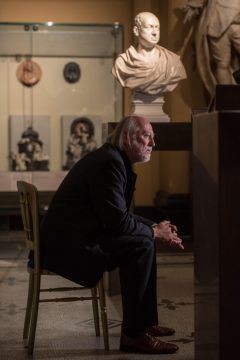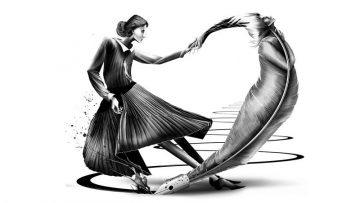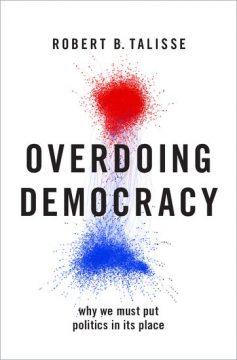David Graeber in the New York Review of Books:

There is a growing feeling, among those who have the responsibility of managing large economies, that the discipline of economics is no longer fit for purpose. It is beginning to look like a science designed to solve problems that no longer exist.
A good example is the obsession with inflation. Economists still teach their students that the primary economic role of government—many would insist, its only really proper economic role—is to guarantee price stability. We must be constantly vigilant over the dangers of inflation. For governments to simply print money is therefore inherently sinful. If, however, inflation is kept at bay through the coordinated action of government and central bankers, the market should find its “natural rate of unemployment,” and investors, taking advantage of clear price signals, should be able to ensure healthy growth. These assumptions came with the monetarism of the 1980s, the idea that government should restrict itself to managing the money supply, and by the 1990s had come to be accepted as such elementary common sense that pretty much all political debate had to set out from a ritual acknowledgment of the perils of government spending. This continues to be the case, despite the fact that, since the 2008 recession, central banks have been printing money frantically in an attempt to create inflation and compel the rich to do something useful with their money, and have been largely unsuccessful in both endeavors.
We now live in a different economic universe than we did before the crash. Falling unemployment no longer drives up wages. Printing money does not cause inflation. Yet the language of public debate, and the wisdom conveyed in economic textbooks, remain almost entirely unchanged.
More here.

 After breakfast one morning in August, the mathematician
After breakfast one morning in August, the mathematician  This impeachment is so confusing. Both sides are making contradictory claims and it’s almost impossible to know who to trust.
This impeachment is so confusing. Both sides are making contradictory claims and it’s almost impossible to know who to trust. Savage Appetites, Rachel Monroe’s probing, recursive study, per the subtitle, of “women, crime, and obsession,” attempts to explain to themselves and the rest of us those women running in place while fixed on a master broadcast of ritual female destruction. A magazine writer known for her laser-cut dissections of cresting cultural phenomena, Monroe brings a rare form of joy to her reporting: Her best pieces combine a focused effort to nail down a good story and a more expansive instinct toward unraveling, questioning, showing her work. Writing about social-media hucksters, dating-app con men, and new-old wellness elixirs, she exhibits a gift—perhaps prized even more by editors than it is among journalists—for the precise interval at which a sort-of thing is ready to become a full-on thing, to be caught mid-microcurrent, skillfully examined, and released into the slightly wider waterways that now pass for the mainstream.
Savage Appetites, Rachel Monroe’s probing, recursive study, per the subtitle, of “women, crime, and obsession,” attempts to explain to themselves and the rest of us those women running in place while fixed on a master broadcast of ritual female destruction. A magazine writer known for her laser-cut dissections of cresting cultural phenomena, Monroe brings a rare form of joy to her reporting: Her best pieces combine a focused effort to nail down a good story and a more expansive instinct toward unraveling, questioning, showing her work. Writing about social-media hucksters, dating-app con men, and new-old wellness elixirs, she exhibits a gift—perhaps prized even more by editors than it is among journalists—for the precise interval at which a sort-of thing is ready to become a full-on thing, to be caught mid-microcurrent, skillfully examined, and released into the slightly wider waterways that now pass for the mainstream. László Krasznahorkai is a Hungarian writer born in 1954. His first novel,
László Krasznahorkai is a Hungarian writer born in 1954. His first novel,  In her 1931 essay “Professions for Women”, Woolf recalled that thrill of transforming from “a girl in a bedroom with a pen in her hand” to “a professional woman”, her opinions solicited and rewarded by wages she could spend, once rent and bills were covered, on “an extravagant little table” or a “long coveted & resisted coal scuttle” (money, she wrote in A Room of One’s Own, “dignifies what is frivolous if unpaid for”). But the sense of independence afforded by this work was not purely, or even primarily, financial. When she first sat down to write a damning review of a book by a respected gentleman, Woolf was haunted by a phantom voice urging her not to criticize but to charm and flatter, to speak in the language traditionally deemed womanly. She named this spectre the “Angel in the House”, after Coventry Patmore’s poem about the cloying, self-sacrificing ideal of Victorian womanhood; her imagined admonishment – “Never let anybody guess that you have a mind of your own” – nearly “plucked the heart out of my writing”. Conquering the urge to submit to that voice, Woolf concluded, was a prerequisite not only for writing, but for freedom in all aspects of life. The TLS’s affirmation helped Woolf to unmake assumptions of how women should think and behave, and find a new language in which to express herself, ignoring the insistent reminder that there were things “which it was unfitting for her as a woman to say”. Soon after her first reviews were published, seeking respite from dull commissions (“a nondescript book like this which really suggests nothing good or bad, is damned hard work”), she began on the novel that would become her debut, The Voyage Out. Virginia Woolf was launched.
In her 1931 essay “Professions for Women”, Woolf recalled that thrill of transforming from “a girl in a bedroom with a pen in her hand” to “a professional woman”, her opinions solicited and rewarded by wages she could spend, once rent and bills were covered, on “an extravagant little table” or a “long coveted & resisted coal scuttle” (money, she wrote in A Room of One’s Own, “dignifies what is frivolous if unpaid for”). But the sense of independence afforded by this work was not purely, or even primarily, financial. When she first sat down to write a damning review of a book by a respected gentleman, Woolf was haunted by a phantom voice urging her not to criticize but to charm and flatter, to speak in the language traditionally deemed womanly. She named this spectre the “Angel in the House”, after Coventry Patmore’s poem about the cloying, self-sacrificing ideal of Victorian womanhood; her imagined admonishment – “Never let anybody guess that you have a mind of your own” – nearly “plucked the heart out of my writing”. Conquering the urge to submit to that voice, Woolf concluded, was a prerequisite not only for writing, but for freedom in all aspects of life. The TLS’s affirmation helped Woolf to unmake assumptions of how women should think and behave, and find a new language in which to express herself, ignoring the insistent reminder that there were things “which it was unfitting for her as a woman to say”. Soon after her first reviews were published, seeking respite from dull commissions (“a nondescript book like this which really suggests nothing good or bad, is damned hard work”), she began on the novel that would become her debut, The Voyage Out. Virginia Woolf was launched. SAN FRANCISCO — Last fall, Google unveiled a breakthrough artificial intelligence technology called BERT that changed the way scientists build
SAN FRANCISCO — Last fall, Google unveiled a breakthrough artificial intelligence technology called BERT that changed the way scientists build Winter is changing its character. Since the beginning of the 21st century, glaciers have been melting at record speed. In Central Asia, they’ve lost approximately one quarter of their volume over the past 50 years. An ice grotto in Switzerland that is creeping down the slope as the Rhône Glacier advances is now covered with white blankets every summer to help preserve it. When a glacier ceases to flow and begins to melt, glaciologists use the term dead-ice, and when dead-ice melts completely, it leaves behind an uneven terrain full of potholes. Depending on their shape and location, these are known as donuts, puckered lips, or kettles. The highest ski resort in the world used to be on the glacier at the summit of Mount Chacaltaya in Bolivia. The glacier, 17,785 feet above sea level, disappeared years ago, and scientists have calculated that glaciers will continue to melt even if humans somehow manage to reduce the amount of greenhouse gases entering the atmosphere.
Winter is changing its character. Since the beginning of the 21st century, glaciers have been melting at record speed. In Central Asia, they’ve lost approximately one quarter of their volume over the past 50 years. An ice grotto in Switzerland that is creeping down the slope as the Rhône Glacier advances is now covered with white blankets every summer to help preserve it. When a glacier ceases to flow and begins to melt, glaciologists use the term dead-ice, and when dead-ice melts completely, it leaves behind an uneven terrain full of potholes. Depending on their shape and location, these are known as donuts, puckered lips, or kettles. The highest ski resort in the world used to be on the glacier at the summit of Mount Chacaltaya in Bolivia. The glacier, 17,785 feet above sea level, disappeared years ago, and scientists have calculated that glaciers will continue to melt even if humans somehow manage to reduce the amount of greenhouse gases entering the atmosphere.
 Maxwell’s Demon is a famous thought experiment in which a mischievous imp uses knowledge of the velocities of gas molecules in a box to decrease the entropy of the gas, which could then be used to do useful work such as pushing a piston. This is a classic example of converting information (what the gas molecules are doing) into work. But of course that kind of phenomenon is much more widespread — it happens any time a company or organization hires someone in order to take advantage of their know-how. César Hidalgo has become an expert in this relationship between information and work, both at the level of physics and how it bubbles up into economies and societies. Looking at the world through the lens of information brings new insights into how we learn things, how economies are structured, and how novel uses of data will transform how we live.
Maxwell’s Demon is a famous thought experiment in which a mischievous imp uses knowledge of the velocities of gas molecules in a box to decrease the entropy of the gas, which could then be used to do useful work such as pushing a piston. This is a classic example of converting information (what the gas molecules are doing) into work. But of course that kind of phenomenon is much more widespread — it happens any time a company or organization hires someone in order to take advantage of their know-how. César Hidalgo has become an expert in this relationship between information and work, both at the level of physics and how it bubbles up into economies and societies. Looking at the world through the lens of information brings new insights into how we learn things, how economies are structured, and how novel uses of data will transform how we live. In prose both sophisticated and accessible to the lay reader, Robert B. Talisse’s Overdoing Democracy sets forth the case for a national reckoning on how our addiction to politics is undermining the purposes for which democracy was conceived.
In prose both sophisticated and accessible to the lay reader, Robert B. Talisse’s Overdoing Democracy sets forth the case for a national reckoning on how our addiction to politics is undermining the purposes for which democracy was conceived. November 22nd, 2019 is the bicentenary of the birth of George Eliot (Mary Ann Evans, 1819-80). Eliot was the last in an extraordinary sequence of women novelists in nineteenth century England that included Jane Austen, the Brontë sisters and Elizabeth Gaskell. Her novel Middlemarch (1871-72) is generally considered to be the culminating achievement of the Victorian realist tradition. In transposing the ethical capital of Christianity to the secular world, she retained a fervent belief in the redemption offered by the expansion of human knowledge and a co-ordinate growth in sympathetic feeling. Most of her heroines yearn for education and a sense of social purpose as well as for love and marriage. How do such ambitions look in the globalised, information-saturated present, where many young women have far greater opportunities for specialised education? Can we still imagine that the novel could contribute to the redemption of the world? Sally Rooney’s allusions to Eliot, as well as to Austen, in her two best-selling campus-based novels, Conversations with Friends (2017) and Normal People (2018), offer an unexpected Irish millennial salute to this humanist line of ameliorative fiction by English women.
November 22nd, 2019 is the bicentenary of the birth of George Eliot (Mary Ann Evans, 1819-80). Eliot was the last in an extraordinary sequence of women novelists in nineteenth century England that included Jane Austen, the Brontë sisters and Elizabeth Gaskell. Her novel Middlemarch (1871-72) is generally considered to be the culminating achievement of the Victorian realist tradition. In transposing the ethical capital of Christianity to the secular world, she retained a fervent belief in the redemption offered by the expansion of human knowledge and a co-ordinate growth in sympathetic feeling. Most of her heroines yearn for education and a sense of social purpose as well as for love and marriage. How do such ambitions look in the globalised, information-saturated present, where many young women have far greater opportunities for specialised education? Can we still imagine that the novel could contribute to the redemption of the world? Sally Rooney’s allusions to Eliot, as well as to Austen, in her two best-selling campus-based novels, Conversations with Friends (2017) and Normal People (2018), offer an unexpected Irish millennial salute to this humanist line of ameliorative fiction by English women. Prunella Clough, a superbly weird British modernist who died in 1999, at the age of eighty, was fond of a quote by Édouard Manet: “Painting is like throwing oneself into the sea to learn to swim.” Looking at art can be like that, too—both a crash course and a full-body experience. Visitors to the newly renovated moma are invited to take that kind of plunge in the show “The Shape of Shape,” installed in a small gallery on the fifth floor, filled with an exhilarating abundance of seventy-one paintings, sculptures, photographs, drawings, and prints in the museum’s collection. They were selected by the voraciously smart Amy Sillman, a superbly weird painter herself (she contributes a blood-crimson wall work, equal parts shadow and viscera), who chose the catchall concept of “shape” because it’s off the grid, rarely discussed, as opposed to related principles like color or systems. Sillman muses in her introductory wall text that shape may be “too personal, too subjective, to be considered rigorously modern.” In keeping with the rehang throughout the new building, hidebound hierarchies of modernism are reconsidered. While the show doesn’t stint on acknowledged Masters (no Manet, but there is a Matisse), the emphasis is on oddballs like Clough, whose orphic 1985 painting “Stone” is included.
Prunella Clough, a superbly weird British modernist who died in 1999, at the age of eighty, was fond of a quote by Édouard Manet: “Painting is like throwing oneself into the sea to learn to swim.” Looking at art can be like that, too—both a crash course and a full-body experience. Visitors to the newly renovated moma are invited to take that kind of plunge in the show “The Shape of Shape,” installed in a small gallery on the fifth floor, filled with an exhilarating abundance of seventy-one paintings, sculptures, photographs, drawings, and prints in the museum’s collection. They were selected by the voraciously smart Amy Sillman, a superbly weird painter herself (she contributes a blood-crimson wall work, equal parts shadow and viscera), who chose the catchall concept of “shape” because it’s off the grid, rarely discussed, as opposed to related principles like color or systems. Sillman muses in her introductory wall text that shape may be “too personal, too subjective, to be considered rigorously modern.” In keeping with the rehang throughout the new building, hidebound hierarchies of modernism are reconsidered. While the show doesn’t stint on acknowledged Masters (no Manet, but there is a Matisse), the emphasis is on oddballs like Clough, whose orphic 1985 painting “Stone” is included. ‘Pre-Raphaelite Sisters’ takes the Pre-Raphaelite Brotherhood, fades out the central figures and asks those previously known for their supporting or peripheral roles to step forward. It pays attention to models such as Fanny Cornforth and Annie Miller, investigates the activities of the wives of some of its leading figures, including Jane Morris, Georgiana Burne-Jones and Effie Gray Millais, and celebrates the art of such sculptors and painters as Maria Zambaco and Marie Spartali Stillman. It is, in effect, a cultural history of the Pre-Raphaelite Brotherhood in its focus on how clients were tended, studios managed, costumes stitched, parallel careers pursued, opportunities for work seized and respectability either sought or rejected. It unfolds a fascinating series of interconnected life stories.
‘Pre-Raphaelite Sisters’ takes the Pre-Raphaelite Brotherhood, fades out the central figures and asks those previously known for their supporting or peripheral roles to step forward. It pays attention to models such as Fanny Cornforth and Annie Miller, investigates the activities of the wives of some of its leading figures, including Jane Morris, Georgiana Burne-Jones and Effie Gray Millais, and celebrates the art of such sculptors and painters as Maria Zambaco and Marie Spartali Stillman. It is, in effect, a cultural history of the Pre-Raphaelite Brotherhood in its focus on how clients were tended, studios managed, costumes stitched, parallel careers pursued, opportunities for work seized and respectability either sought or rejected. It unfolds a fascinating series of interconnected life stories. One of the central questions I’m asking myself is how to fit the human being into our current understanding of both natural scientific fact and the social and general mental and interpretative facts unearthed by the humanities and social sciences. Where do we locate the human being and what we know about ourselves from humanistic, historically oriented research vis-à-vis contemporary technology, the digital sphere, cutting-edge research in physics, neuroscience, etc.?
One of the central questions I’m asking myself is how to fit the human being into our current understanding of both natural scientific fact and the social and general mental and interpretative facts unearthed by the humanities and social sciences. Where do we locate the human being and what we know about ourselves from humanistic, historically oriented research vis-à-vis contemporary technology, the digital sphere, cutting-edge research in physics, neuroscience, etc.? The authors’ argument goes like this. The emergence of agriculture 12,000 years ago favored societies that could work together on big projects, like growing crops. This kind of collaboration required people to be members of tightly bound social networks, strengthened by individuals who showed solidarity with one another. Families in farming societies fostered intense connection among people, because their survival depended on it: extended relatives lived under one roof, polygamy was often allowed, and people married within their own communities and families. Practices like ancestor worship and shared ownership further strengthened these bonds, both in Europe and in many farming societies around the agricultural world.
The authors’ argument goes like this. The emergence of agriculture 12,000 years ago favored societies that could work together on big projects, like growing crops. This kind of collaboration required people to be members of tightly bound social networks, strengthened by individuals who showed solidarity with one another. Families in farming societies fostered intense connection among people, because their survival depended on it: extended relatives lived under one roof, polygamy was often allowed, and people married within their own communities and families. Practices like ancestor worship and shared ownership further strengthened these bonds, both in Europe and in many farming societies around the agricultural world.